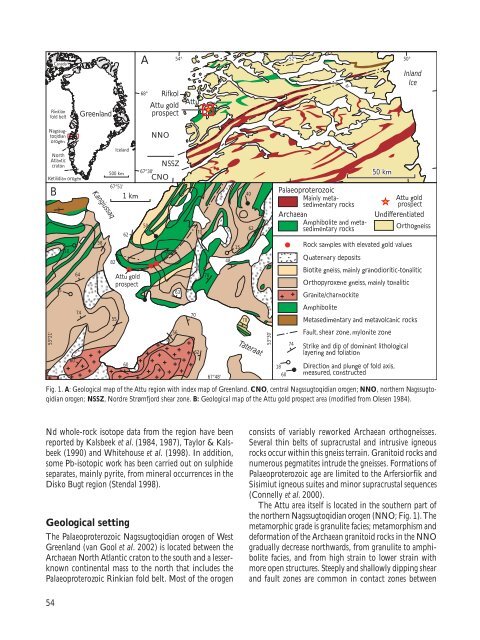Geological Survey of Denmark and Greenland Bulletin 11 ... - GEUS
Geological Survey of Denmark and Greenland Bulletin 11 ... - GEUS
Geological Survey of Denmark and Greenland Bulletin 11 ... - GEUS
You also want an ePaper? Increase the reach of your titles
YUMPU automatically turns print PDFs into web optimized ePapers that Google loves.
53°21'<br />
B<br />
Canada<br />
Rinkian<br />
fold belt<br />
Nagssugtoqidian<br />
orogen<br />
North<br />
Atlantic<br />
craton<br />
Ketilidian orogen<br />
75<br />
18<br />
60<br />
64<br />
74<br />
Greenl<strong>and</strong><br />
Greenl<strong>and</strong><br />
Inl<strong>and</strong> Ice<br />
Inl<strong>and</strong><br />
Ice<br />
Kangiussaq<br />
58<br />
82<br />
55<br />
Icel<strong>and</strong><br />
500 km<br />
67°51'<br />
1 km<br />
62<br />
Attu gold<br />
prospect<br />
60<br />
A<br />
68°<br />
67°30'<br />
50<br />
60<br />
54°<br />
Attu gold<br />
prospect<br />
NNO<br />
CNO<br />
Rifkol<br />
NSSZ<br />
70<br />
56<br />
63<br />
Attu<br />
70<br />
62<br />
70<br />
70<br />
67°48'<br />
48<br />
15<br />
70<br />
40<br />
62<br />
Tater at<br />
53°30'<br />
Palaeoproterozoic<br />
Mainly metasedimentary<br />
rocks<br />
Archaean<br />
Amphibolite <strong>and</strong> metasedimentary<br />
rocks<br />
18<br />
60<br />
52°<br />
74<br />
Ar<br />
Inl<strong>and</strong><br />
Ice<br />
Attu gold<br />
prospect<br />
Undifferentiated<br />
Rock samples with elevated gold values<br />
Quaternary deposits<br />
50 km<br />
Orthogneiss<br />
Biotite gneiss, mainly granodioritic-tonalitic<br />
Orthopyroxene gneiss, mainly tonalitic<br />
Granite/charnockite<br />
Amphibolite<br />
Metasedimentary <strong>and</strong> metavolcanic rocks<br />
Fault, shear zone, mylonite zone<br />
Strike <strong>and</strong> dip <strong>of</strong> dominant lithological<br />
layering <strong>and</strong> foliation<br />
Direction <strong>and</strong> plunge <strong>of</strong> fold axis,<br />
measured, constructed<br />
Fig. 1. A: <strong>Geological</strong> map <strong>of</strong> the Attu region with index map <strong>of</strong> Greenl<strong>and</strong>. CNO, central Nagssugtoqidian orogen; NNO, northern Nagssugtoqidian<br />
orogen; NSSZ, Nordre Strømfjord shear zone. B: <strong>Geological</strong> map <strong>of</strong> the Attu gold prospect area (modified from Olesen 1984).<br />
50°<br />
Nd whole-rock isotope data from the region have been<br />
reported by Kalsbeek et al. (1984, 1987), Taylor & Kalsbeek<br />
(1990) <strong>and</strong> Whitehouse et al. (1998). In addition,<br />
some Pb-isotopic work has been carried out on sulphide<br />
separates, mainly pyrite, from mineral occurrences in the<br />
Disko Bugt region (Stendal 1998).<br />
<strong>Geological</strong> setting<br />
The Palaeoproterozoic Nagssugtoqidian orogen <strong>of</strong> West<br />
Greenl<strong>and</strong> (van Gool et al. 2002) is located between the<br />
Archaean North Atlantic craton to the south <strong>and</strong> a lesserknown<br />
continental mass to the north that includes the<br />
Palaeoproterozoic Rinkian fold belt. Most <strong>of</strong> the orogen<br />
consists <strong>of</strong> variably reworked Archaean orthogneisses.<br />
Several thin belts <strong>of</strong> supracrustal <strong>and</strong> intrusive igneous<br />
rocks occur within this gneiss terrain. Granitoid rocks <strong>and</strong><br />
numerous pegmatites intrude the gneisses. Formations <strong>of</strong><br />
Palaeoproterozoic age are limited to the Arfersiorfik <strong>and</strong><br />
Sisimiut igneous suites <strong>and</strong> minor supracrustal sequences<br />
(Connelly et al. 2000).<br />
The Attu area itself is located in the southern part <strong>of</strong><br />
the northern Nagssugtoqidian orogen (NNO; Fig. 1). The<br />
metamorphic grade is granulite facies; metamorphism <strong>and</strong><br />
deformation <strong>of</strong> the Archaean granitoid rocks in the NNO<br />
gradually decrease northwards, from granulite to amphibolite<br />
facies, <strong>and</strong> from high strain to lower strain with<br />
more open structures. Steeply <strong>and</strong> shallowly dipping shear<br />
<strong>and</strong> fault zones are common in contact zones between<br />
54
















